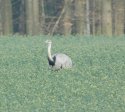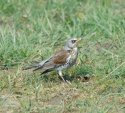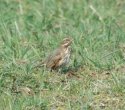
Northern Europe
has several unusual exotic introductions (aka
plastics), this was a trip
to see some of them as well
as some real birds (I haven’t gone totally mad).
Targets were Sacred Ibis, Reeve’s
Pheasant, Bobwhite, Grey headed Woodpecker,
Black Woodpecker, Red Billed Leiothrix, Rhea, Carribean
Flamingo, Chilean Flamingo,
Lesser Whitefronted
Goose, House Crow.
|
9th February - France
After the 1.15am le shuttle we headed south to Brittany,
the long drive was broken up by a few sleep stops and we arrived late
morning, to beautiful sunshine and warm weather although E35 lighter due to
motorway tolls. As we headed towards Le Croisic our target was in sight,
eight sacred ibis feeding in a damp
field with gulls. We then headed to the town itself and went to the beach –
well had to in that weather. All the usual shore birds were present with
several black necked grebes off
shore of note, we headed to the lagoons which held large numbers of little egrets and a rather nice marsh harrier but not much else. We
returned to the ibis for a while before heading north. A white stork was of note on the journey. Our destination was the
farmland area around Puiseaux, I had contacted a local hunter to get some
information on where they hunt Bobwhite, the hunters was a little vague but
gave the general area. This was where we headed, we drove around and around
the farmland of the area, through small villages and eventually just as we
were to give up a bobwhite was
flushed from the verge by the car, just south of Gironville. We headed to our
hotel (Formula 1) near Nemours.
|

Sacred Ibis

Sacred Ibis
|
|
10th February – France
Again
We were at the site at dawn, but
could not find the correct track so we searched the woods from the all tracks
without success; it was overcast and chilly but did not rain good conditions
for birdwatching. We gave up and headed to (A birdwatching guide to France
Crozier - Paris Region Area 6 Site 1) as we arrived a grey headed woodpecker flew across the road. I lept out as it
flew away. I had a look for it without success but did find a middle spotted woodpecker. We headed
down the road several middle spotted
woodpeckers were with tit flocks, bullfinch,
nuthatches and great spotted
woodpeckers also seen. We reached the end of the road and on the
way back heard a loud call, I tracked the source down and a black woodpecker was located although
not particularly close. We then after a bit of lunch headed to Freemainville
north of Paris, our route skirted
Paris and we could even see the
Eiffel tower. We found the site easily and headed into the woods by the pond,
a few marsh tits with the tit
flock and several short toed
treecreepers. We crossed to the other side of the track and headed into
the woods. A short way in a red billed leiothrix was spotted chasing a robin they were easily located with
their call and at least 5 individuals were seen. We had a long drive so
started off as the light faded During a stop I noticed a tick on my arm no
doubt from the woods.
|

Red Billed Leiothrix

Red Billed Leiothrix
|
|
11th February – Germany
A long journey broken with a long
stop for sleep we awoke to lots of snow and sub zero temperatures. The roads
were very dodgy but we made it to our destination of Schattin just south of Lubeck.
We had a drive round willow tits
and fieldfares were abundant we
located a rough legged buzzard one
of many seen during the day but we could not locate our target which was
surprising as they are so large. The Nandu as they are locally known are
Rheas which have escaped from a local farm and now have a population of
approx. 100. They live in the farmland around the villages of Schattin and
Utecht. We visited the Wald Hotel in Schattin where the local expert filled
me in on them, but today with the snow he said they would sit tight and not
feed and we would be very lucky to find them but he gave us the best recent
areas. We searched all the areas, following all the small lanes which was
tough in the snow and up one of these lanes at a dead end while turning round
the frozen crust of the earth gave way and we were stuck in the mud. A phone
call to the AA and help was on its way although the location was unknown so I
agreed to meet in the village, a Northern
long tailed titwe seen on the way. The German AA equivalent had a little chuckle on finding
our predicament but quickly towed us out and were on our way again. We
searched everywhere but no luck, we saw some goosander on the river and a distant flock of geese were
inspected and they were common cranes
two groups of about a dozen each coming in to roost, we had no luck with the
Nandu, the weather had beaten us and we headed west to warmer climes, they
will have to keep for another day.
|

Red billed Leiothrix Map

Me in the Snow

Unusual Sign
|
|
12th February – Netherlands
We stayed in Assen, the Netherlands
in a quite posh hotel, which was part of the reason for setting off late as
it was well comfy. We had a traffic jam in the worsening weather, heavy rain
and high winds and eventually made our first destination Elburg where both Chilean and Caribbean flamingo’s
were wintering. 12 and 1 respectively. This is not the only site, they break
up into small groups during the winter before returning to the Dutch/German
border to breed they number approx 70-100 Chilean and a few Caribbean, all
originally from escaped stock but now breeding well. The weather worsened not
allowing many photo’s to be taken as was the case all day, as even standing
up was difficult, we took a look round and found a great white egret. The next stop was Petten Polder on the west
side where several lesser whitefronted geese had been seen regularly.
Eventually they were seen but I had to hold the scope to stop it from blowing
over, the girlfriend only leaving the car when I found 3 lesser whitefronted geese in the whitefronts, barnacles and greylags. Lots of widgeon and curlew about as well. We headed to our next destination at the Hook
of Holland, Egyptian
geese noted on the way. We arrived and parked, two local birdwatchers
were on hand sheltering from the weather, with that old line should have been
here 5 mins ago, they were right in front of us. Eventually I did get a
flight view of a house crow, one
of a small population that live by the railway station. They came on a boat
from the far east, only numbering 20 or so. I did find one on a boat later on
in the fading light that gave better views and that was it time to head for
home.
|

Flamingo’s

Flamingo’s
|
Birds - 99
|
Black
Necked Grebe
|
Great
Crested Grebe
|
Cormorant
|
|
Little
Egret
|
Grey
Heron
|
Great
White Egret
|
|
White
Stork
|
Chilean
Flamingo
|
Caribbean Flamingo
|
|
Mute
Swan
|
White-fronted
Goose
|
Lesser
White-fronted Goose
|
|
Greylag
Goose
|
Barnacle
Goose
|
Canada
Goose
|
|
Egyptian
Goose
|
Brent
Goose
|
Mallard
|
|
Shelduck
|
Gadwall
|
Wigeon
|
|
Tufted
Duck
|
Goldeneye
|
Goosander
|
|
Red
Breasted merganser
|
Marsh
Harrier
|
Rough
Legged Buzzard
|
|
Buzzard
|
Kestrel
|
Bobwhite
|
|
Common
Pheasant
|
Moorhen
|
Coot
|
|
Common
Crane
|
Oystercatcher
|
Ringed
Plover
|
|
Grey
Plover
|
Lapwing
|
Dunlin
|
|
Turnstone
|
Redshank
|
Curlew
|
|
Black
Headed Gull
|
Common
Gull
|
Herring
Gull
|
|
Yellow
Legged Gull
|
Greater
Black backed gull
|
Feral
Pigeon
|
|
Stock
Dove
|
Woodpigeon
|
Collared
Dove
|
|
Black
Woodpecker
|
Great
spotted woodpecker
|
Middle
spotted woodpecker
|
|
Grey
Headed Woodpecker
|
Skylark
|
Rock
Pipit
|
|
Meadow
Pipit
|
White
Wagtail
|
Wren
|
|
Dunnock
|
Robin
|
Red
Billed Leothrix
|
|
Stonechat
|
Song
Thrush
|
Redwing
|
|
Mistle
Thrush
|
Fieldfare
|
Blackbird
|
|
Goldcrest
|
Great
tit
|
Long
tailed tit
|
|
Long
tailed tit (??)
|
Coal
tit
|
Blue
Tit
|
|
Willow Tit
|
Marsh
Tit
|
Nuthatch
|
|
Short
toed Treecreeper
|
Magpie
|
Jay
|
|
Carrion
Crow
|
Rook
|
House
Crow
|
|
Jackdaw
|
Raven
|
Starling
|
|
House
Sparrow
|
Tree
Sparrow
|
Chaffinch
|
|
Lesser
redpoll
|
Siskin
|
Goldfinch
|
|
Greenfinch
|
Bullfinch
|
Hawfinch
|
|
Yellowhammer
|
Sacred
Ibis
|
Red
Legged Partridge
|
Mammals - 5
|
Rabbit
|
Hare
|
Muskrat
(Dead)
|
|
Roe
Deer
|
Fallow
Deer
|
|
Literature
French Maps - OK
IGN 2221 O, 221 E and 2417 OT
1:25,000 ISBN 3 282112221130, 3 282112121249, 3 282112417045
German Map – Which was rubbish
BDR Number 3 1:100,000 no ISBN no
Dutch Maps – Excellent
ANWB 15 and 10 1:50,000 ISBN 9
789018018986 and 9 789018021276
A Birdwatching
guide to France
(North of the Loire) J. Crozier
ISBN 1 900159767
Details of the Sacred Ibis,
Reeve’s pheasant and Red billed Leothrix sites were
from Rich Bonsers trip report (here)
Return to Nandu
We made a quick return to Germany to find the Rhea's in late March.
|
1st April
All day was rather touristy, but a selection of gulls and ducks inc goosanders were present in town but little else. Late afternoon we took a drive back to the Rhea area but nothing but deer before our late flight home.
31st March
d
A rather busy week at work prevented me from any birding at all, and this weekend was booked up with a trip to Lubeck, Germany part touristy but also to find the Rheas or Nandu as they are locally know present in the area which we missed a couple of months earlier in our Europe (plastic) Trip Report. within 10 mins of leaving the airport we were in the area and we spent much of the day searching, without success. We did see several buzzards, goshaw and a red kite. A small pond held a pair of goosanders and a white wagtail. A trip to the local town produced a selection of food for lunch. A wider search produced lots of the commoner birds, a large flock of redwings and fieldfares. Some helpful locals had seen a flock of 60 or so in the past few days and showed us where but to no avail. I took a walk up a track, where I met another birdwatcher who was there for a breeding bird survey of some rare birds, he asked me not to disclose its location or the species. We walked up the track and a rhea was in a rape field. The birdwatcher continued to his destination and the rhea was watched in the field. I returned to the car for the camera, girlfirend etc. and went back to my vantage point, the rhea had gone, but continuing down the track, its head could be seen above the rape. It was easily hidded even in the foot or so high rape. Our vantagepoint was a deer stalkers platform where we had good views of the rhea and several pairs of common cranes displaying an excellent sight, as was a close passing hen harrier. After having our fill we headed to Lubeck for the evening, a bat sp was of note.
|
|














